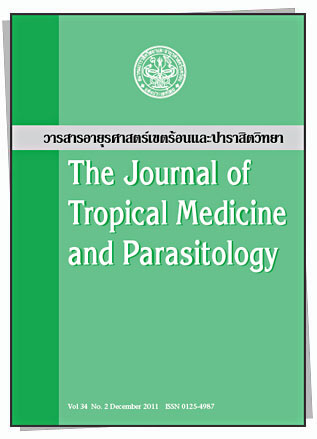Parasitic and Enteric Bacterial Infections among Food Handlers in Tourist-area Restaurants and Educational-institution Cafeterias, Sai-Yok District, Kanchanaburi Province, Thailand
Main Article Content
Abstract
Abstract
This study aimed to determine the health status of food handlers working in the cafeterias ofeducational institutions, and those working in the restaurants of a tourist area in Sai-Yok District,Kanchanaburi Province, Thailand. A total of 273 stool samples were collected: 29.3% (80/273) fromfood handlers in the educational institutions, and 70.7% (193/273) from food handlers in touristarearestaurants. In all, 266 (97.4%) participants agreed to complete the study questionnaire. Thestool samples collected were examined by direct smear and Kato-Katz modified thick-smear, andcultured for bacterial infections by agar plate method. The prevalence of intestinal parasites was10.3% (28/273). Among these, hookworm was the most common (70.0%), followed by Entamoeba coli(10.0%), Trichuris trichiura (10.0%), Blastocystis hominis (3.3%), Giardia lamblia (3.3%), and Endolimaxnana (3.3%). All stool cultures tested negative for enteropathogenic bacteria. Helminth infectionswere less prevalent among the food handlers from the educational institutions. A medical check-upprogram with health education could improve workers’ health status.
Keywords: food handler, intestinal parasites, enteropathogenic bacteria, Kanchanaburi, Thailand

